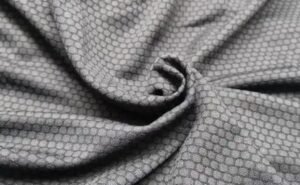
Fabric Structure
Knitting is formed by bending the yarn into loops in sequence, and the loops are connected to each other to form a fabric. Woven weaving is formed by weaving two or more sets of mutually perpendicular yarns with a 90 degree angle of longitude and latitude. The longitudinal yarn is called warp, and the transverse yarn is called weft.
Physical Mechanics
The physical and mechanical properties of knitted fabrics are very good, including longitudinal density, transverse density, square meter weight, elongation, elasticity, breaking strength, coverage and bulk density. The physical and mechanical properties of woven fabrics only include the yarn density of warp and weft, edge, front and back, along and against wool direction, fabric coverage.
Basic unit of fabric weave
The smallest unit of knitted fabric is the loop. The coil is composed of the coil stem and the extension line in a space curve. The smallest unit of a woven fabric is the weave point, that is, every intersection point between the warp and the weft. Woven is the process of forming loops of yarn, which can be carried out horizontally or longitudinally. Horizontal weaving is called weft knitting fabric, and longitudinal weaving is called warp knitting fabric. There are two types of knitting: manual knitting and machine knitting. Manual knitting uses stick needles, which have a long history, exquisite skills, and flexible patterns. It has been widely spread and developed among the people.
In short, the clothes made of knitted fabrics are knitted clothes like sweaters, gloves, socks, underwear and other knitted fabrics. The simplest and unprofessional way to distinguish knitting from tatting is that knitted fabrics are elastic and can be stretched. Woven fabrics are basically inelastic (except for very few).

Use of woven and knitted clothing
Knitted fabric
Because the knitted outer garment fabric has good elasticity, the knitted outer garment is more suitable for casual wear and sportswear. According to the use, knitted outerwear can be divided into the following categories.
- Knitted sportswear: Sportswear is the traditional field of knitted outerwear and plays an important role in the knitted outerwear market. Knitted sportswear varies according to different seasons, sports events and occasions. Knitted sportswear has a wide variety of styles.
- Casual clothes for daily use: As people are more and more inclined to wear comfortable and casual clothes, casual formal clothes have become the trend of clothing development, and knitted casual clothes are becoming the main product in this field,such as T-shirts, travel casual clothes, student clothes and casual clothes for daily use.
- Knitted social dress: various social dresses are made with the characteristics of knitted fabrics, such as elasticity and drapability, which are elegant and luxurious.
Woven fabric
Woven fabric is suitable for various cutting methods because of its stable structure, flat cloth surface and no sag when hanging. Woven fabrics are mainly used in the following aspects:
- Clothing fabric: mainly used for various clothing, underwear, skirts, suits, sportswear series, etc.
- Bedding fabrics: various fabrics used in the series of sheets, quilt covers, pillow cases, bedding, quilt covers, pillows, blankets, etc.
- Decorative materials: various curtains, fabrics, sofa covers, cushions, cushions, foot mats, various carpets, tapestries, etc.
- Other home textile fabrics: various towels, bath towels, handkerchiefs, hats, gloves, scarves, and other fabrics.
Advantages and Disadvantages of Woven and Knitted Garments
woven fabric advantages and disadvantages
The advantages of woven fabric are mainly shown in its strong fabricability, convenient dyeing, good comfort, wear resistance and durability, constant size, cleaning, etc. It plays an important role in the production of medium and high-end clothing.
However, woven fabrics stretch in all directions and are not as elastic as knitted fabrics; Moreover, it is not as breathable as knitted fabric, and the handle is hard.
Knitted fabric advantages and disadvantages
Knitted fabric is soft and comfortable, with great elasticity, and can be freely retracted, which can achieve the effect of comfortable wearing and free movement. The disadvantages are also obvious: weft knitted fabrics are easy to disperse. When the yarn on the knitted fabric is broken or the coil loses the connection of string and sleeve, causing separation between coils, the coil will be separated along the longitudinal direction, which will affect the appearance and strength of the fabric.
In addition, knitted fabrics are easy to hook silk, fuzz and pilling. Due to the loose organizational structure of knitted fabrics, the fibers on the fabrics are easy to be hooked up by sharp and hard objects to form silk loops during processing and use. At the same time, fibers are often fuzzed due to wear, which will directly affect the functional properties.

Considerations for choosing knits
- Nowadays, many knitted clothes are made of chemical fiber, so you’d better smell them before buying them. Odourless smell is the best. Otherwise they will be harmful to your skin.
- The elasticity of knits is very important. When purchasing, stretch the surface of the clothes to check the elasticity of the knitting. The knits with poor elasticity are easy to deform after washing.
- Be sure to open the inside of the clothes to see the washing instructions, and ask the shopping guide whether they need dry cleaning, whether they can be exposed to the sun and other questions for future care.
- It is necessary to check whether the joints of all the yarns on the surface of the sweater are smooth, whether the knitting lines are consistent, and whether the color of the yarn is symmetrical.After carefully watching the selection, you will buy the sweater with confidence.







